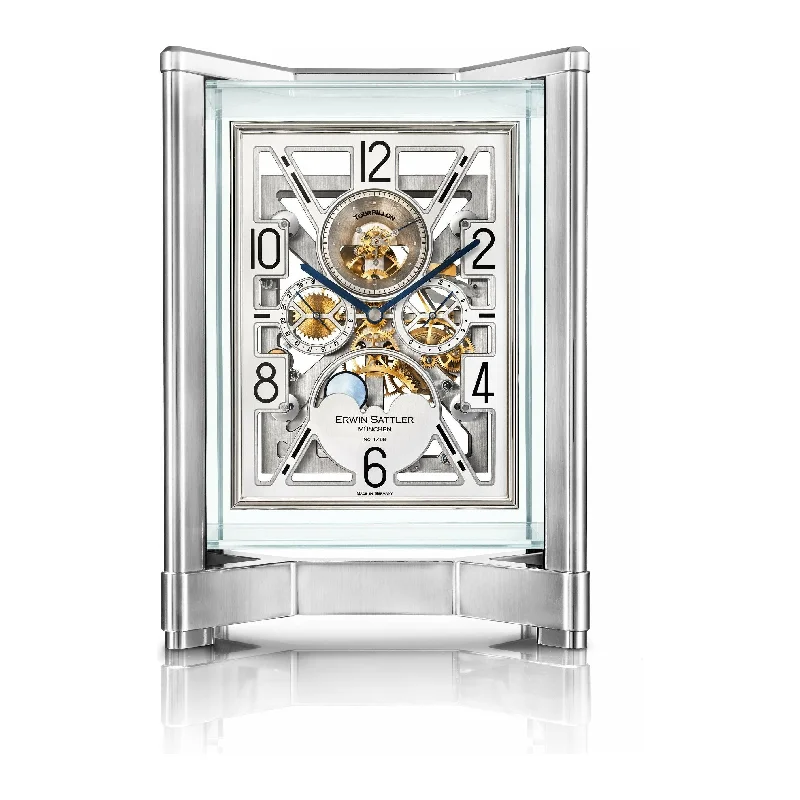THE NEW SHINING TABLE CLOCK IN A POLISHED STAINLESS-STEEL CASE
All parts of the solid stainless-steel case are individually milled, grounded and carefully polished by hand in elaborate and limited small series. Due to the special design of the case construction (which is also used in the precision pendulum clock Opus Perpetual), almost no edges of the case glass can be seen. This creates the amazing effect that the viewer has an apparently floating clockwork in front of him.
The Erwin Sattler manufacture caliber 1399-1, with a 14-day clockwork, the display of the date, moon phase and power reserve, impresses not only with its aesthetic and at the same time technically sophisticated design, but above all with the embedded minute tourbillon.
This “crowning achievement” of watchmaking can be traced back to the famous watchmaker Abraham-Louis Breguet, who had the brilliant idea in 1801. The flying variant, based on a further development by Alfred Helwig, means a further increase in complexity, since it is only stored on the back and thus allows an unobstructed view of the escapement. The tourbillon with all its filigree parts, worked down to the last detail, can really show off its shine. Embedded in the funnel gemmed with 12 diamonds, it is the sparkling eye-catcher of every Opus Tourbillon!
Features
Case: Height: 36 cm, width: 24 cm, depth: 14 cm (H14.2" x W9.4" x D5.5")
Chime: Passing strike with bell
Crystal: Anti-reflective mineral glass
Weight: 10,5 kg
Movement: Sattler calibre 1399-1
Power reserve: 15 days
Drive: Mainspring with fusee for constant force
Oscillator: One-minute flying tourbillon with screw balance
Dial: Anodised, power reserve indicator, date display, "small
second", moon phase display with hand polished nacre discs
Ball bearings: 12 precision ball bearings
Beat rate: 18.000/h
Jewels: 11
Limited to 58 pieces.
(Only a limited number available!)
HIGHLIGHTS
One-minute flying tourbillon in a funnel set with 12 brilliant-cut diamonds.
Unobscured view of the movement through 6 panes of mineral glass.
15-day power reserve indicator and date display on the subsidiary dial, moon phase display wit a mother of pearl disc.
THE OPUS TOURBILLON COMES WITH A HIGHLY SOPHISTICATED HOROLOGICAL COMPLICATION
When renowned clockmaker Abraham-Louis Breguet invented the tourbillon in 1801, he not only improved the precision of pocket chronometers but also gifted the world of watchmaking with a highly refined mechanism. The tourbillon is a special mechanism that corrects any inaccuracies caused by the timepiece being in a certain position. Breguet’s work was based on the observation that gravity has a negative impact on the accuracy of the movement. Every time the position of the timepiece changes when worn, the force of gravity affects the accuracy of the time shown. To solve this problem, the ingenious clockmaker mounted the entire escapement (comprising balance wheel, spring, pallet lever and escape wheel – the components that are most sensitive to the effects of gravity) inside a mobile cage that turns once on its axis every minute.

